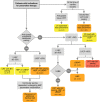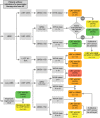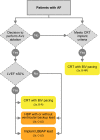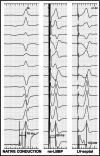2023 HRS/APHRS/LAHRS guideline on cardiac physiologic pacing for the avoidance and mitigation of heart failure
- PMID: 37799799
- PMCID: PMC10549836
- DOI: 10.1002/joa3.12872
2023 HRS/APHRS/LAHRS guideline on cardiac physiologic pacing for the avoidance and mitigation of heart failure
Abstract
Cardiac physiologic pacing (CPP), encompassing cardiac resynchronization therapy (CRT) and conduction system pacing (CSP), has emerged as a pacing therapy strategy that may mitigate or prevent the development of heart failure (HF) in patients with ventricular dyssynchrony or pacing-induced cardiomyopathy. This clinical practice guideline is intended to provide guidance on indications for CRT for HF therapy and CPP in patients with pacemaker indications or HF, patient selection, pre-procedure evaluation and preparation, implant procedure management, follow-up evaluation and optimization of CPP response, and use in pediatric populations. Gaps in knowledge, pointing to new directions for future research, are also identified.
Keywords: cardiac resynchronization therapy; conduction system pacing; guideline; his bundle pacing; left bundle branch area pacing.
© 2023 Heart Rhythm Society, the Asia Pacific Heart Rhythm Society, and the Latin American Heart Rhythm Society published by Elsevier Inc and Wiley.
Figures













References
-
- European Heart Rhythm Association; European Society of Cardiology; Heart Rhythm Society; Heart Failure Society of America; American Society of Echocardiography; American Heart Association; European Association of Echocardiography; Heart Failure Association , Daubert J‐C, Saxon L, Adamson PB, et al. 2012 EHRA/HRS expert consensus statement on cardiac resynchronization therapy in heart failure: implant and follow‐up recommendations and management. Heart Rhythm. 2012;9:1524–76. 10.1016/j.hrthm.2012.07.025 - DOI - PubMed
-
- Kusumoto FM, Schoenfeld MH, Barrett C, et al. 2018 ACC/AHA/HRS guideline on the evaluation and management of patients with bradycardia and cardiac conduction delay: executive summary: a report of the American College of Cardiology/American Heart Association Task Force on Clinical Practice Guidelines, and the Heart Rhythm Society. Heart Rhythm. 2019;16:e227–79. 10.1016/j.hrthm.2018.10.036 - DOI - PubMed
-
- Graham R, Mancher M, Miller Wolman D, Greenfield S, Steinberg E, editors. Institute of Medicine Committee on Standards for Developing Trustworthy Clinical Practice Guidelines. Clinical Practice Guidelines We Can Trust. Washington, DC: National Academies Press; 2011. - PubMed
-
- Halperin JL, Levine GN, Al‐Khatib SM, et al. Further evolution of the ACC/AHA Clinical practice guideline recommendation classification system: a report of the American College of Cardiology/American Heart Association Task Force on Clinical Practice Guidelines. J Am Coll Cardiol. 2016;67:1572–4. 10.1016/j.jacc.2015.09.001 - DOI - PubMed
Grants and funding
LinkOut - more resources
Full Text Sources
Research Materials
Miscellaneous

